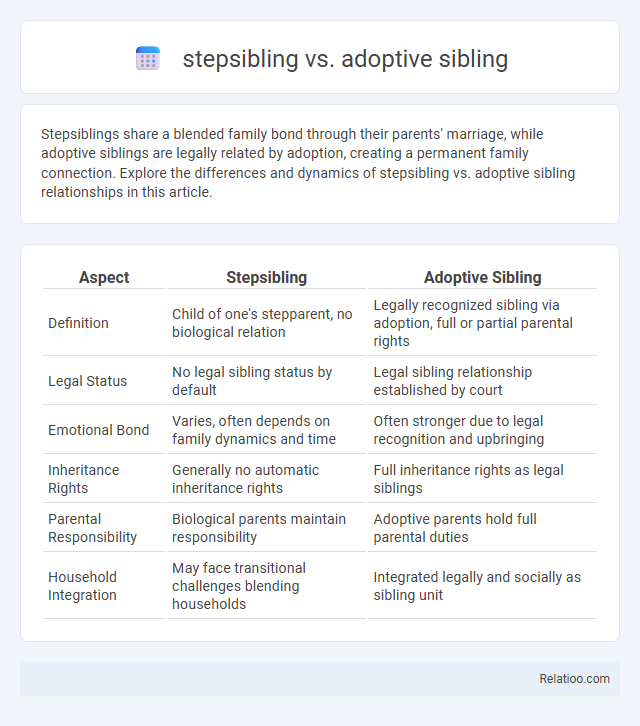Stepsiblings share a blended family bond through their parents' marriage, while adoptive siblings are legally related by adoption, creating a permanent family connection. Explore the differences and dynamics of stepsibling vs. adoptive sibling relationships in this article.
Table of Comparison
| Aspect | Stepsibling | Adoptive Sibling |
|---|---|---|
| Definition | Child of one's stepparent, no biological relation | Legally recognized sibling via adoption, full or partial parental rights |
| Legal Status | No legal sibling status by default | Legal sibling relationship established by court |
| Emotional Bond | Varies, often depends on family dynamics and time | Often stronger due to legal recognition and upbringing |
| Inheritance Rights | Generally no automatic inheritance rights | Full inheritance rights as legal siblings |
| Parental Responsibility | Biological parents maintain responsibility | Adoptive parents hold full parental duties |
| Household Integration | May face transitional challenges blending households | Integrated legally and socially as sibling unit |
Definition of Stepsibling and Adoptive Sibling
Stepsiblings are children related through the marriage of their respective parents, without any biological or legal adoption connection. Adoptive siblings, however, share a legal parent-child relationship established through the formal adoption process, creating a permanent familial bond recognized by law. Understanding these definitions helps You navigate the distinctions between family ties formed by marriage versus those created by adoption.
Formation of Stepsibling Relationships
Stepsibling relationships form when two individuals gain siblings through the marriage of their respective parents, creating family ties without biological or legal adoption links. Adoptive sibling relationships arise when children are legally adopted by the same parents, establishing a permanent familial bond through legal processes. Your understanding of these differences is crucial for recognizing the unique emotional and social dynamics inherent in each type of sibling connection.
Formation of Adoptive Sibling Bonds
Adoptive sibling bonds form through legal and emotional integration when a child is formally adopted into a family, creating a permanent familial relationship regardless of biological ties. Stepsibling relationships arise when parents marry, blending two separate family units without inherent legal adoption, often requiring time and shared experiences to develop strong bonds. Your adoptive siblings become legally recognized family members, with rights and responsibilities similar to biological siblings, which shapes a unique dynamic distinct from stepsibling connections.
Legal Status and Rights Comparison
Stepsiblings and adoptive siblings differ significantly in legal status and rights; adoptive siblings share a legal family bond through formal adoption, granting them inheritance rights, custody considerations, and familial benefits under the law. Stepsiblings, formed through the marriage of their respective parents, generally lack automatic legal rights such as inheritance or custody unless legally adopted or specified in a will. Understanding these distinctions is crucial for navigating family law matters related to custody, inheritance, and parental responsibilities.
Family Dynamics and Adjustment
Stepsiblings often navigate complex family dynamics marked by initial unfamiliarity and the blending of previous households, requiring emotional adjustment and the development of new trust patterns. Adoptive siblings typically share a legal and emotional bond established through adoption processes, which can foster a strong sense of belonging but may also involve navigating identity and attachment issues. Stepsiblings are more likely to experience fluctuating roles and boundaries compared to adoptive siblings, emphasizing the importance of communication and flexibility for successful family integration.
Emotional Challenges and Attachments
Stepsiblings often face unique emotional challenges due to sudden family restructuring, requiring time to build trust and form attachments without biological ties. Adoptive siblings may experience complex feelings about identity and belonging, balancing biological connections outside the home with strong familial bonds within it. Both relationships benefit from open communication and patience to foster emotional security and positive attachments.
Identity Development in Stepsiblings vs Adoptive Siblings
Identity development in stepsiblings often involves navigating complex family dynamics and boundary redefinition, while adoptive siblings typically experience identity formation influenced by legal and emotional integration into the family. Your sense of belonging in stepsibling relationships may fluctuate due to varying degrees of acceptance and ongoing adjustments, whereas adoptive siblings usually benefit from stable affirmations of family identity and shared history. Understanding these distinctions helps clarify emotional challenges and support mechanisms unique to each sibling type.
Cultural and Social Perceptions
Stepsiblings are often perceived as family members formed through marriage, leading to variable acceptance influenced by cultural emphasis on blood relations. Adoptive siblings are more widely recognized across cultures as equal family members due to legal and emotional bonds established through adoption processes. Social perceptions tend to grant adoptive siblings stronger familial legitimacy compared to stepsiblings, reflecting cultural values on biological ties versus chosen family structures.
Navigating Roles and Boundaries
Navigating roles and boundaries between stepsiblings and adoptive siblings requires clear communication and mutual respect to foster healthy relationships. Stepsiblings, connected through their parents' marriage without legal ties, often need explicit discussions to define personal space and emotional limits, while adoptive siblings, legally bonded through adoption, share a family structure that encourages deeper emotional integration and long-term commitment. Establishing boundaries based on individual comfort levels and family dynamics is essential for all siblings to build trust and support within blended or adoptive families.
Support Systems and Resources for Blended Families
Stepsiblings and adoptive siblings both play crucial roles in the evolving dynamics of blended families, offering diverse emotional support and shared experiences. Resources for blended families include counseling services tailored to navigate complex relationships, offering stepsiblings and adoptive siblings tools for communication and conflict resolution. You can strengthen your family bond by accessing support groups and educational programs that address the unique challenges faced by stepsiblings and adoptive siblings within blended households.

Infographic: stepsibling vs adoptive sibling
 relatioo.com
relatioo.com